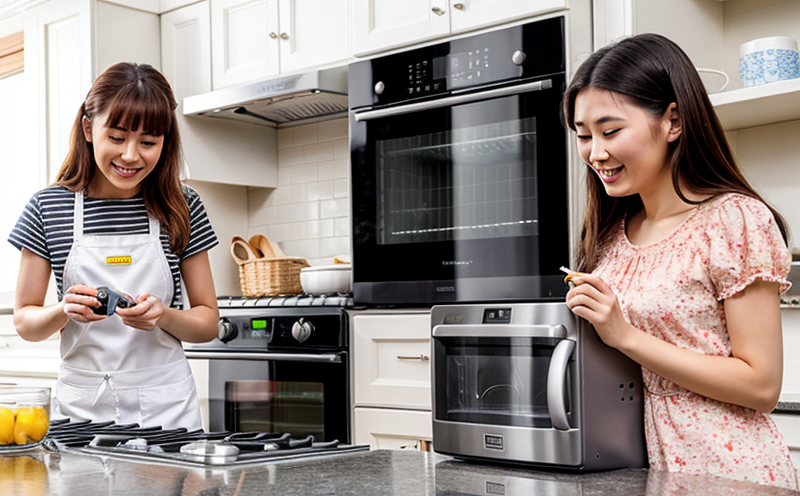IEC 60335 2 31 Safety Testing for Range Hoods
The IEC 60335-2-31 standard is an international guideline that sets out the safety requirements and test procedures specifically for range hoods. This document ensures that all electrical appliances used in kitchens meet stringent safety standards, protecting users from potential hazards such as fire, electric shock, and harmful emissions.
The scope of IEC 60335-2-31 includes a variety of tests designed to evaluate the overall safety performance of range hoods. These tests cover aspects like electrical insulation, mechanical stability, ventilation efficiency, and noise levels. Compliance with these standards is crucial for manufacturers aiming to ensure their products meet global market requirements.
The testing process begins with thorough preparation of the specimen according to the standard's specifications. This includes ensuring that all components are in working order and that the unit is assembled correctly. Following this, various tests such as electrical insulation resistance measurement, overcurrent protection verification, and ventilation performance analysis are conducted using specialized equipment.
The results from these tests provide critical data on whether a range hood complies with IEC 60335-2-31 requirements. Compliance ensures that the product is safe to use in residential settings without posing risks to users or the environment. For manufacturers, this compliance also opens up opportunities for broader market access and consumer trust.
For quality managers and R&D engineers involved in the development of range hoods, understanding these standards is essential. It helps them design products that not only meet but exceed safety expectations while maintaining efficiency and functionality. Compliance with IEC 60335-2-31 also aids procurement teams by ensuring they source components from reliable suppliers who adhere to stringent quality controls.
Given the importance of this standard, it is recommended that manufacturers conduct regular audits against these guidelines. This proactive approach ensures continuous improvement and helps maintain a high level of safety standards in their products. By adhering to IEC 60335-2-31, companies can build strong reputations for producing safe and reliable kitchen appliances.
- Electrical insulation resistance measurement
- Overcurrent protection verification
- Ventilation performance analysis
- Noise level assessment
- Mechanical stability check
- Emission testing
- Labeling and marking review
The comprehensive nature of IEC 60335-2-31 makes it a cornerstone for ensuring the safety and quality of range hoods across different regions. By following this standard, manufacturers can ensure their products are safe, efficient, and compliant with international standards.
Why It Matters
The significance of IEC 60335-2-31 lies in its role as a benchmark for safety and quality assurance. Compliance with this standard ensures that range hoods are safe to operate, reducing the risk of accidents such as fires or electrical shocks. For manufacturers, adhering to these standards not only enhances product reliability but also opens up markets where stringent safety regulations apply.
From an environmental perspective, IEC 60335-2-31 promotes sustainable practices by encouraging the use of energy-efficient appliances and reducing waste through proper disposal guidelines. This contributes positively towards reducing the ecological footprint associated with household electrical appliances.
Compliance also enhances consumer trust, which is vital for brand reputation and customer satisfaction. When consumers know their range hoods meet rigorous safety standards like those set out in IEC 60335-2-31, they are more likely to purchase from reputable brands that prioritize user safety.
For R&D engineers involved in the design process of range hoods, understanding this standard is crucial. It helps them incorporate necessary safety features into their designs early on, ensuring compliance without compromising functionality or aesthetics.
In summary, IEC 60335-2-31 is essential for maintaining high standards of safety and quality in household electrical appliances like range hoods. Its implementation benefits everyone involved—from manufacturers striving to meet global market demands to end-users who benefit from safer products.
Customer Impact and Satisfaction
IEC 60335-2-31 plays a pivotal role in enhancing customer satisfaction by ensuring that range hoods are safe, efficient, and reliable. When customers know their appliances meet stringent safety standards like those set out in this document, they feel more confident in purchasing them.
- Reduces the risk of accidents such as fires or electric shocks
- Eases regulatory compliance issues for consumers
- Promotes trust and loyalty among users
- Encourages repeat purchases from satisfied customers
Moreover, IEC 60335-2-31 supports sustainable practices by promoting the use of energy-efficient appliances. This not only helps reduce environmental impact but also contributes to cost savings for consumers in terms of reduced utility bills.
In conclusion, IEC 60335-2-31 significantly impacts customer satisfaction and loyalty. By ensuring that range hoods meet rigorous safety standards, manufacturers can build strong reputations for producing safe and reliable kitchen appliances. This ultimately leads to increased customer confidence and satisfaction.
Environmental and Sustainability Contributions
The IEC 60335-2-31 standard also has significant contributions towards environmental sustainability. By promoting the use of energy-efficient range hoods, it helps reduce overall electricity consumption in households. This reduction in energy usage translates into lower greenhouse gas emissions, contributing positively to global efforts against climate change.
Additionally, the standard encourages proper disposal practices for household electrical appliances at the end of their lifecycle. This ensures that hazardous materials do not end up in landfills but are instead managed responsibly through recycling or other environmentally friendly methods.
The implementation of IEC 60335-2-31 fosters a culture of environmental responsibility among consumers and manufacturers alike. It serves as an important tool for promoting sustainable practices within the kitchen appliance industry, ultimately leading to greater collective efforts towards protecting our planet.





